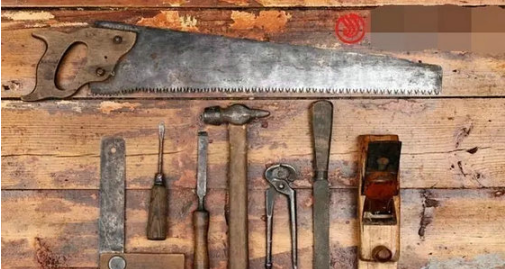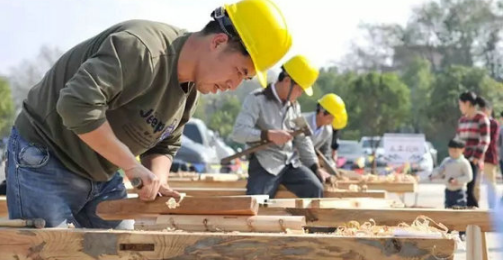The quality of "Made in China" products raises concerns for all people, especially the children's furniture industry is calling for "artisan spirit." As a result, the government work report on the "two sessions" of the country has also had to mention a certain amount, and it is necessary to return to and carry forward the traditional "artisan spirit."
When it comes to craftsmanship, it is naturally reminiscent of the wooden furniture in the various museums, the delicately crafted wares, and the few buildings that will last for millenniums. If we look at the museums in Japan again, most of their stuff at the same time is almost worthless (and today we are rushing toward Japanese goods). We wish to restore our "artisan spirit", which probably stems from this.
But the accumulation of some treasures for thousands of years may not necessarily reflect the full connotation of the craftsmen's work, or at least not what we might imagine, from which we can inherit some "spirit."

Does traditional craftsmen have "spirit"?
Mr. Yu Tongyuan, a history scholar at Soochow University, has written more than 500 pages of “Modern Transformation of Traditional Craftsmenâ€, which outlines the true social situation of traditional craftsmen:
First, the personal attachment is strong and the social status is low. Jin Wenzhong's "hundred workers" is similar to slaves' handicraft labor. Many of the later official craftsmen were criminals. After the Tang and Song Dynasties, the status of handicraftspeople has improved, but “emphasis on agriculture and suppression of commerce†is still a basic national policy. By the Yuan Dynasty, it began to adopt a strict “carpentry†system, which imposed various restrictions and enslavement on artisans.
Second, hereditary status and occupational fixed. Prior to the abolition of the craftsmanship system in the early Qing Dynasty, craftsmen were strictly limited by the household registration system of the government craftsmen and military households. Not only were the profession inherited from the family, but the entire industry survived. Even after the craftsmanship system was abolished, the craftsman’s occupational life and the phenomenon of family life still exists. The benefit of the worldly family business is to facilitate the accumulation of technology. However, whether or not there will be "artisan spirit" will be a problem to be demonstrated.
The third is that the organization is closed and the group's right to speak is small. China established the craftsmanship system and the duties of managing craftsmen very early, but the craftsmen’s own organization appeared very late. This is very different from the fact that the medieval guilds in Europe occupied the city and achieved autonomy in the struggle for power. Even in the vast historical books, we can hardly know the names of several craftsmen. More are emperors, politicians, literati, etc. Wait.

In summary, the craftsmen of ancient China not only had low social and political status, but also scattered. How could such groups create something called “spirituality�
As for the ancient Chinese "craftsmen" who can make their productions beautiful enough, in addition to the above-mentioned hereditary and genealogical techniques, it is also the implementation of the system of "revolutionary workers' names" and the system of "workers and effective workers".
The so-called "revolutionary name" means that every product must be engraved with the name of a craftsman so that the relevant department at a higher level can inspect and check it. The so-called "worker-worker" means that the leader of the higher authorities in charge of "workers" will inspect and inspect the craftsmen's products. Unqualified products will appear and the craftsmen will be punished. Conversely, if the products are of good quality, they will be rewarded.
And in fact, the mainstream ideology of ancient China advocates simplicity and opposes “strange arts and delicaciesâ€. In today’s words, it is against innovation, requires ingenuity, and is large enough to build houses and furniture, and to make furniture and objects. Programs, levels are not very high, and innovation is not recognized. This is in line with China’s profound tradition of exegesis and annotation.
Modern craftsman back to the light
After the Qing Dynasty, the craftsmen system was abolished and the official craftsmen were scattered into the private sector. Their skills became an important source of family income.
In the traditional agricultural society, the most important cash income is still the sale of agricultural and sideline products: food, cash crops and livestock, etc. In the final analysis, they deal with the land. In the medium to long term, what kind of things are actually the same for a family. Occasionally, there are some exceptions. For example, before and after 1984, the traditional Chinese medicine of Sichuan in Sichuan was sold for 30-40 yuan per kilogram, and there was 10,000 yuan in revenue per acre. That year, Chuanxiong was excited. Extremely, he has never seen such a lot of money in his life; he has not planted his breasts and lost his chance to make a fortune in a one-hundred year.
However, these are "floating money," and after the limelight is often muddy, one foot will make a big deal. In addition to earning a living, it is more reliable to learn a craft. Being a craftsman is a good choice.
Until the era of the People's Commune, the plasterer, the carpenter, the sculptor, the craftsman, and the mason were all managed separately. They are called "five-workers" and are often needed in rural life. They also learn the most.
However, each craftsman has slightly different qualification requirements. The carpenter is the most demanding of the people, followed by the plasterer; the carver is mainly a woodcarving, and has a high aesthetic ability; “the workman†(“solution†reads in the dialect like “changeâ€) when the PLA captured Sichuan. The locals called it a "replacement of the military," and it was only after a generation that it was renamed the "liberation army." It was a big saw that two people used five feet to make a long saw. The sawing of logs into planks was a heavy manual work. The lean-bodied Chengdu poet Liushahe was sent back to his original woodworking factory in Jintang during the "Cultural Revolution". He had been working hard for his death for nearly 10 years. His implied meaning was still considered by craftsmen as "a Industry"; stonemason is mainly the processing of stones into life or production tools.
The most rigorous relationship is the carpenter. The carpenter is divided into large wood and small wood. Big wood is mainly responsible for building houses, and Xiaomu is mainly responsible for making wooden furniture. It is impossible to learn how to polish a large number of woods of various specifications and shapes and then spliced ​​them together, without the hardships of three years or more. Therefore, learning to live in a carpenter is mostly a rural young man who has a lot of thoughts. After studying, he works at the owner’s house, pays for the day, supplies three meals a day, and drinks and treats at night; if the person is stupid, the master is often not willing to accept it as an apprentice. Even if you are barely full, you will not find jobs in the future.
The second best thing to do is learn the plasterer. The craftsman's work environment is not as clean as a carpenter. But this is much easier to compare with a carpenter. It pays attention to the vertical and horizontal walls, and the brick seams look like a straight line, unlike carpenters. Of course, there are also unique skills, such as building stoves, some of the stoves made by plasterers, not prosperous, too much firewood, and some muders do the stove, but it can make people satisfied.
The number of sculptors and masons is much less, mainly because they are less alive and the competition is not fierce. Therefore, their livelihood is somewhat rough and there are no special requirements. The host family will also be on the job.
The craftsmen are often two-person groups. They stand face-to-face in front of a wooden stand and pull their arms to the left and right all day long. They can't even saw the boards undulating. Therefore, they must have good energy and good eyesight.
Modern craftsman ashes away
The more important identities of the above five craftsmen are farmers. They lived the work of the five craftsmen, mostly in the slack season, during the busy season, and the owner’s family did not arrange to build houses and furniture. In the era of the People's Commune, the five craftsmen were engaged in the work of the five divisions, mostly in the slack season, and they did not obey the production team when they were busy. Not only did they earn no cents, but they also received penalties. The compromise was to pay cash to the production team.
In the years following the reform and opening up, without these restrictions, the economy developed rapidly. The range of activities of the five craftsmen was no longer limited to the local township. Some people went to the city and went to the field to contract for construction sites. They soon became contractors.
The first contractors were mainly plasterers. This is because the civil engineering in the city has used power facilities, the importance of carpenters has decreased, and the demand for plasterers has been extremely strong. The position of the plasterer stands out, among which the brains are flexible and become managers or contractors. The first millionaires were mostly plasterers. A handful of these people, if they have not been eliminated by the market, have survived and later pulled up construction companies and have huge family-owned assets.
Carpenters in the country can only watch as the muddy craftsmen who have not been able to win their eyes get rich. They either make doors or windows for farmers in their hometowns, or they work as templates on the construction site. Small days can be considered decent, 90s of the last century. A multi-purpose small-scale electric wood processing machine has rapidly become popular. Carpenters no longer need training for three to five years. It takes only a few months or even less. Even worse, the modern furniture factory was established quickly, the product was smooth and shiny, and the design was modern and fashionable. However, traditional wood handmade furniture always had such flaws from design to work, and it quickly lost. The use of timber in housing construction has also been greatly reduced. Plastic windows and custom doors have caused traditional carpenters to completely lose their market.
With the use of power tools for wood and stone carving, the traditional craftsmanship of the sculptor and the mason also quickly lost; the arrival of the electric saw made the open wood flat and straight, and the craftsmen disappeared overnight. There is no end to the movie.
In my hometown, old-fashioned craftsmen are getting old and traditional crafts are actually disappearing. In the earlier industrialized Jiangnan area, the disappearance of traditional artisans was even earlier. Some time ago in the ancient town of Zhujiajiao, Shanghai, I met a 60-year-old system-maker who had previously been a carpenter, an ancestral craftman, to him. There was no business for this generation, and it was simply a sign of change. His son preferred to go to the company to be a "white-collar worker" who did not earn much, and he did not want to inherit his ancestral skills.
Traditional craftsmen have been crushed in the face of modern machinery, and people are unable to return to God. Under such circumstances, the spirit of artisans is being called to whom?
Anything called "spiritual" is a product of free will. In this sense, Zhuangzi praised Kenting, whose split beef was "into the way" and entered the realm of spiritual creation. When the craftsman’s social status is shaped like a slave, there will be no “artisan spiritâ€; when the craftsman’s social status is low, his career is only a means of earning a living. Whenever opportunities arise, he must be separated and how he will be able to create “ Spiritually? When the reward for artisan workers is to “work for work,†it also fails to create “spirit.†Until today, after the college entrance examination is completed, candidates are required to apply for advanced craftsmanship in higher vocational colleges. This is mostly a last resort choice.
The repression caused by the social atmosphere on craftsmen is far from fading.
The company's Sports Equipment Co., Ltd. mainly produces outdoor combination slides, kindergarten toys, children's furniture, outdoor development equipment, fitness equipment, naughty Fort, etc. It is a science and technology enterprise integrating design, production, sales, and after-sale. Website:. Advisory telephone. The company's pleasure and dedication to serve you! Factory address: No. 16, Chuangqiang Road, Lucheng District, Wenzhou City Light Industry Park.
UPLIFTEC is manufacturer and distributor of linear actuators and linear motion control products worldwide. We have over 7 years of experience in the industry. We have developed and designed a wide range of products to match the growing demand for automation across industries. We also have a great collection of motion control systems for all our linear actuators that can be easily connected to customers units and equipments. Our high quality actuator products have been used specific in particular projects such as an automated door, remote control system, mobile applications, automated furniture for smart houses much more.

Electric Linear Actuator,Linear Actuator,Motorized Linear Actuator,Heavy Duty Linear Actuator,Linear Actuator 24v
Suzhou Uplift Intelligent Technology Co., Ltd , https://www.upliftecdesk.com
